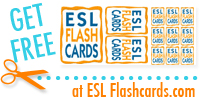Teaching English to a two- or three-year old can be a lot of fun. Small children are energetic and love learning, they pick things up quickly and theyíre so gosh-darn cute! Still, it can be intimidating; what do you do about temper tantrums, or diapers, or if the child gets hurt? If youíre thinking about teaching at this age level, be sure you know what youíre getting into.
Communicate with the parents.
Be sure that the parents of your student are aware of your methods and expectations, and how you believe their child will benefit from them. This can be difficult if you donít share a language, but itís very important. If you favor a gentle memorization-free learning approach, and the childís parents want him to be able to recite the ABCís, you could be in for a clash down the line unless you reach a compromise.
Itís also important to be clear on whether you will be responsible for discipline, caring for the child unsupervised, changing diapers, etc. Be sure youíre comfortable with what the parents expect of you.
Think outside the classroom.
Especially if you have the parentsí cooperation, thereís a lot you can do with a toddler outside of the normal flashcard games. Think of how many different things you could talk about in a park, or in the local supermarket. One of the more memorable lessons I have taught involved a trip to the pet store with my student and her father. If the parents are agreeable, snacks are a fun way to talk about tastes and the names of food- I recommend fruits! Art projects such as collages are a good way to talk about colors, use lots of vocabulary, and practice following directions. Additionally, before a snack or after an art project, you have the chance to talk about hand washing. To a child in this age group, anything can be an opportunity to learn, and thatís one of the most exciting aspects of teaching them.
Have a plan (and be willing to trash it).
Toddlers pick up on your emotions, and if you are nervous and uncomfortable, they are likely to be the same. However, if you are confident in a well planned lesson, it is much more likely that the child will be interested and engaged.
Unfortunately, though, there are exceptions to every rule. Sometimes an activity you were sure would be a hit flops; sometimes the childís interest is just elsewhere. For example, I planned several activities for one lesson, and at the last minute stuck some cardboard shape cutouts in my bag. My plan was a loss, but tracing the cutouts occupied the student for at least twenty minutes. Another time, my student had just watched a television show about tooth brushing, and we spent almost the whole lesson pretending to clean the teeth of a toy hippo.
The best lesson plans, Iíve found, consist of many simple activities that can be swapped around to suit the mood of the child. You can find some great ideas to start with at the following webpages.
Gayleís Preschool Rainbow has lots of activities for native English speaking preschoolers and toddlers. Most of the themes are applicable to EFL classes as well.
Preschool Express by Jean Warren has activities for both school and home environments, which means a lot of them work well in one-on-one lessons.
First School has very good printable crafts and activities on a wide range of themes, better for preschoolers than toddlers. Most of the crafts donít require a lot of preparation, so theyíre good when youíre short on time.
Enchanted Learning is a great place to look for craft ideas. Be careful, though; some of the downloads are subscription only.
Have a routine.
A routine that you follow at every lesson not only saves you planning time, but is comfortable for the child. Young children enjoy repetition; itís how they learn. For example, in my group lessons I always begin with a stretching routine followed by a song, and close with sticker books and a goodbye song. The students know what to expect, which helps them to overcome nervousness.
In addition, feel free to repeat an activity that went well. It will probably be as popular the second and third time as it was the first.
Do your research.
Having a basic idea of where your student is developmentally can be a big help in planning appropriate activities. An 18-month-old only knows about fifty words in their native tongue; a three-year old may know more than one thousand. The ability to jump comes around the second birthday, toilet training closer to the third. A game with rules probably would not work well before three years; focus on simpler activities with two-year-olds. Also, be aware that toddlers grow quickly. An activity that was too difficult last month may be perfectly appropriate today.
This website has an easy to understand explanation of one and two year old development.
Hereís a similar page for three and four year olds.
Perhaps the most important thing to remember is also the simplest: Have fun. If you enjoy teaching them, they will enjoy learning from you, and fostering a good attitude about English is one of the best things you can accomplish at this age.






 Linear Mode
Linear Mode








